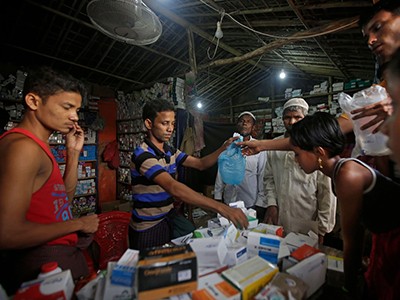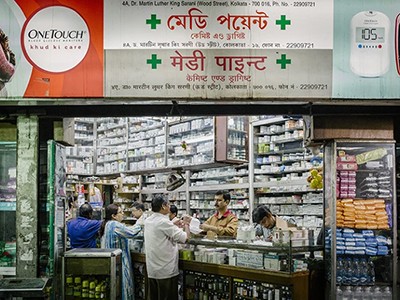The problem of antimicrobial resistance (AMR) — bacteria, fungi or protozoans evolving resistance to antimicrobial substances — is worsening. This month, heads of state are gathering in New York City at the 79th session of the United Nations General Assembly to discuss the issue, among other global challenges.
This is the second time that AMR has been featured at a high-level UN meeting. The first one, in 2016, highlighted the importance of the problem, which is associated with nearly five million deaths each year worldwide. Although there has been some progress in the past eight years, such as the development of national action plans by many countries, the pace of change has been slow. I am presenting at the upcoming meeting, and I hope to convince attendees that the next eight years could look very different.
Tackling antimicrobial resistance needs a tailored approach — four specialists weigh in
One of the main factors driving the global rise of AMR is the use of inappropriate or substandard antibiotics. Indeed, people in low- and middle-income countries, which often lack ‘second-line’ antibiotics — more effective, and often more expensive, than those that are the first choice for treatment — are much more likely to die of infections caused by resistant bacteria than are those in high-income nations. A modelling study published in The Lancet in May (which I was involved in) indicates, however, that even a fairly modest global investment — in the range of hundreds of millions of US dollars — to help prevent bacterial infections and improve access to relatively inexpensive antibiotics could avert millions of deaths (J. A. Lewnard et al. Lancet 403, 2439–2454; 2024).
Each year, about 7.7 million people die from bacterial infections. One-fifth of these are children under the age of five. According to our Lancet study, at least 750,000 of these deaths could be averted through prevention strategies such as providing safe water and good sanitation, ensuring that children receive recommended vaccines, isolating individuals infected with resistant bacteria and implementing protocols to increase the frequency of handwashing in hospitals. Our study also indicates that the largest reduction in deaths would come from improving people’s access to antibiotics that are not available in many countries where most of the world’s bacterial-infection-related deaths occur.
Antibiotic resistance is a growing threat — is climate change making it worse?
Malaria and most bacterial infections do not last as long as do tuberculosis or AIDS, from which people tend to die months or years after infection. A child with an infection who develops a fever in the morning can be dead the next day if they don’t receive the right antibiotics. But in low- and middle-income countries, those are unavailable in many public-sector clinics. Parents and other carers must frequently turn to their local pharmacies for help. Because it is harder in those pharmacies than in public-sector ones to set up systems that limit the entry of inappropriate, poor-quality or fake drugs, hundreds of millions of people are using them.
Bacterial infections have been unfairly neglected — probably because a diverse array of pathogens are responsible for them, so there is no clear group of stakeholders who can advocate for change, as is the case for AIDS, tuberculosis and malaria. Each year, the Global Fund to Fight AIDS, Tuberculosis and Malaria, based in Geneva, Switzerland, spends nearly US$5 billion to ensure that the drugs to treat these diseases are available in low-income countries. These three diseases collectively kill about 2.8 million people each year — less than half the number linked to bacterial infections other than tuberculosis.
The fight against antimicrobial resistance
International funders, such as the Global Fund, must step up. People with HIV have a high risk of developing bacterial, viral, fungal and protozoal infections. Providing people with access to effective diagnostics and antibiotics targeting bacterial infections more broadly would be a natural extension of the Global Fund’s existing mandate.
Furthermore, prevention strategies — especially the provision of vaccines, safe water and good sanitation — need to be supported by organizations such as Gavi, the Vaccine Alliance, as well as through bilateral donors, including the United States Agency for International Development in Washington DC. They also need to be prioritized in national budgets in low- and middle-income countries.
Experience from past UN declarations shows that specific commitments made by countries are more likely to translate into action than is language that is unclear about what is expected of which organizations. The Lancet Series on Antimicrobial Resistance, published in May, calls for a 10% reduction in human mortality from AMR, a 20% reduction in the inappropriate antibiotic use in people and a 30% reduction in the inappropriate antibiotic use in animals by 2030 (see go.nature.com/4d4xg) — all relative to levels in 2019. And support is growing for an independent panel set up by four intergovernmental organizations — the World Health Organization, the United Nations Environment Programme, the Food and Agriculture Organization and the World Organisation for Animal Health — to appraise the evidence around tackling AMR.
With investment from global funders, specific targets and accountability through an independent panel, there is a much higher chance of this year’s discussions at the General Assembly translating into global action to tackle AMR.
Competing Interests
The author declares no competing interests.





